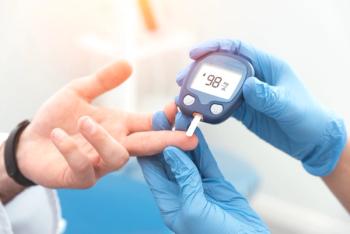
- Consultant for Pediatricians Vol 8 No 10
- Volume 8
- Issue 10
Unusual Lesions-Abuse or Accidental Injury?
Because of the presence of unusual skin findings, a 3-year-old African American girl was evaluated for possible child abuse. The father, the primary guardian, reported that his daughter had returned home from her mother's residence 2 days before-a day earlier than planned. According to the father, the child was crying and had skin lesions, which initially appeared white and then darkened over the course of the next day or two.
THE CASE
Because of the presence of unusual skin findings, a 3-year-old African American girl was evaluated for possible child abuse. The father, the primary guardian, reported that his daughter had returned home from her mother's residence 2 days before-a day earlier than planned. According to the father, the child was crying and had skin lesions, which initially appeared white and then darkened over the course of the next day or two. The mother did not know why the lesions appeared and stated that she had applied a salve to the involved areas.
When the girl was asked, 'How did you get these 'owies'?' she responded, "I swallowed it.' The findings on examination (in the photos shown) appeared virtually unchanged compared with those in photos taken by a detective 2 days earlier. The lesions were nontender and nonpruritic; they did not blanch with pressure. There was some slight discoloration around her mouth but no mucosal involvement.
The social history was significant for 21-year-old parents who did not live together. The father had primary custody because the mother "kept failing drug tests.' The mother practiced hairdressing in her home, and the father was a student. The girl's medical history was significant for mild anemia treated with oral iron. Development was normal and vaccines were up-to-date.
Are these lesions a result of an accident-or do they suggest abuse?
(
Answer: The lesions most likely resulted from an accidental spill of an unknown substance.
THE DISCUSSION
Of the conditions one could include in the differential diagnosis, a hot-liquid burn was not suspected because the injuries never progressed to blisters. A chemical burn was considered because of the mother's occupation as a hairdresser and her use of harsh chemicals in the home.
Hair dye was ruled out because there was no evidence of spillage in the home or on the child's clothes; in addition, one would expect a contact dermatitis, rather than a burn. Hair preparations, such as relaxers, tend to be of high viscosity; thus, a spill pattern such as that in this child would not be expected. Phytophotodermatitis was unlikely because it was winter, and the affected areas had not been exposed to the sun. In addition, the child had had no contact with the usual flora that cause these phototoxic eruptions. Exposure to an illicit drug laboratory was considered because of the mother's history; however, there was no evidence of drug production in the home.
The lesions did not have an inflammatory stage that would suggest postinflammatory hyperpigmentation. A chemical burn from a spill of an unknown substance on the skin seemed to be the most likely explanation. The substance was suspected to be of low viscosity, mainly because there appeared to be some "bleeding' into the cracks of the child's skin. Fluids that are more viscous have a higher resistance to flow and tend to cling to the skin without spreading into its tiny cracks. In addition, the involved area was mostly configured like the spill pattern of a low-viscosity substance (Figure). From the photos, it appeared that the girl had been in a seated position with her right leg bent when the spill occurred. Because the causative agent was not known, no prescription was given, other than routine care and observation for changes or any signs of infection.
Figure – A chemical burn from a spill of a substance with low viscosity was suspected because there appeared to be some “bleeding” into the cracks of the child’s skin, and the involved area was mostly configured like a spill pattern.
The child abuse investigation was prudent in this case because of the mother's lack of an explanation for the injury; this is suspicious for intentional injury or at least neglect or lack of supervision of a 3-year-old who has access to potentially harmful substances.
About a week later, the detective reported that the child's mother had phoned, saying that she "knew what caused the burn.' She had found an empty can of overthe- counter (OTC) wart remover under her bed. It is possible that the child attempted to taste the wart remover but after contact with the liquid, found it to be too cold and, in a reactive manner, pulled the canister away from her mouth, causing the spill.
OTC wart treatments have been in existence for many years. The main ingredient in these products was once salicylic acid. However, new products have been added to the OTC wart removal armamentarium with claims that they are more like liquid nitrogen, the treatment used in physicians' offices. The main ingredient in these newer OTC products is dimethyl ether with propane or isobutene used as a propellant. Unlike liquid nitrogen, which can achieve a temperature of –100°C on skin contact, dimethyl ether, propane, and isobutene reach temperatures only as low as –23º to –20ºC.1 The higher temperatures of these OTC products make them less likely to cause injury in the hands of a layperson.Using the search criteria "adverse effects,' "cryotherapy,' and "nonprescription drugs,' we found only 2 references that discussed cases of partial-thickness burns that resulted from incorrect application of freezing spray.2,3 No references were found that described accidental spilling of the product or hyperpigmentation associated with the use of cryotherapy.
In addition to thermal burns, flame burns are a potential hazard of OTC wart removal products. Both the propane and isobutene used as propellants in these products are highly flammable, and any products containing these chemicals should be used with extreme caution.
The child did not return for a follow-up appointment. However, in a communication via telephone, the mother stated that the affected areas eventually peeled and revealed healthy, normal skin underneath.
Although the exact cause of these acute hyperpigmented patches was not confirmed, the particular pattern of the lesions indicates that something probably spilled on the child and resulted in the discoloration and eventual skin peeling. This case reminds pediatric health care providers that unusual physical examination findings accompanied by an implausible or nonexistent explanation by the child's caregiver should prompt a consideration of physical abuse and neglect.
References:
REFERENCES: 1. Burkhart CG, Pchalek I, Adler M, Burkhart CN. An in vitro study comparing temperatures of over-the-counter wart preparations with liquid nitrogen. J Am Acad Dermatol. 2007;57:1019-1020.
2. Ramsey K, Ragan C, Dheansa B. Adverse effects of over the counter cryotherapy. Burns. 2007;33:533-534.
3. Sammut SJ, Brackley PT, Duncan C, et al. Frostbite following use of a commercially available cryotherapy device for the removal of viral warts. Dermatol Online J. 2008;14:9.
Articles in this issue
about 16 years ago
It Takes a Village to Treat ADHD: Community and Clinical Collaborationsabout 16 years ago
Lichen Striatus on the Arm of a 7-Year-Old Girlabout 16 years ago
Herd Immunity:Another Good Reason to Vaccinateabout 16 years ago
Vaccinating theImmunocompromised Childabout 16 years ago
Point-Counterpoint:Responding to Common Reasonsfor Vaccine Refusalabout 16 years ago
Gunshot Woundabout 16 years ago
Henoch-Schönlein Purpura in an 18-Year-Old Boyabout 16 years ago
Pityrosporum Folliculitisabout 16 years ago
Pediatric Immunization Update-2009Newsletter
Access practical, evidence-based guidance to support better care for our youngest patients. Join our email list for the latest clinical updates.














